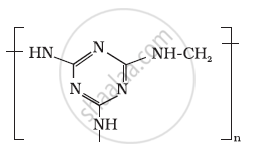Advertisements
Online Mock Tests
Chapters
2: Solutions
3: Electrochemistry
4: Chemical Kinetics
5: Surface Chemistry
6: General Principles and Processes of Isolation of Elements
7: The p-block Elements
8: The d-block and f-block Elements
9: Coordinate Compounds
10: Haloalkanes and Haloarenes
11: Alcohols, Phenols and Ethers
12: Aldehydes, Ketones and Carboxylic Acids
13: Amines
14: Biomolecules
▶ 15: Polymers
16: Chemistry in Everyday Life
Advertisements
Solutions for Chapter 15: Polymers
Below listed, you can find solutions for Chapter 15 of CBSE, Karnataka Board PUC NCERT for Chemistry [English] Class 12.
NCERT solutions for Chemistry [English] Class 12 15 Polymers Intext Questions [Pages 428 - 435]
What are polymers?
Write the names of monomers of the following polymers.

Write the names of monomers of the following polymers:

Write the names of monomer of the following polymer:

Classify the following as addition and condensation polymers: Terylene, Bakelite, Polyvinyl chloride, Polythene.
How are polymers classified on the basis of structure?
Explain the difference between Buna-N and Buna-S
Arrange the following polymers in increasing order of their intermolecular forces.
(i) Nylon 6, 6, Buna-S, Polythene.
(ii) Nylon 6, Neoprene, Polyvinyl chloride.
NCERT solutions for Chemistry [English] Class 12 15 Polymers Exercises [Pages 437 - 438]
Explain the terms polymer
Explain the terms monomer.
What is natural polymer? Give two examples of natural polymers.
What is synthetic polymer? Give two examples of synthetic polymers.
Distinguish between the terms homopolymer and copolymer and give an example of each.
How do you explain the functionality of a monomer?
Define the term polymerisation.
Is (-NH - CHR - CO-)n a homopolymer or copolymer?
In which classes, the polymers are classified on the basis of molecular forces?
How can you differentiate between addition and condensation polymerisation?
Explain the term copolymerisation and give two examples.
Write the free radical mechanism for the polymerisation of ethene.
Define thermoplastics with two examples of each.
Define thermosetting polymers with two examples of each.
Write the names and structures of the monomers of the following polymers: Polyvinyl chloride
Write the names of monomers used for getting the following polymers:
Teflon
Write the name of monomers used for getting the following polymers : Bakelite
Write the name and structure of one of the common initiators used in free radical addition polymerisation.
How does the presence of double bonds in rubber molecules influence their structure and reactivity?
Discuss the main purpose of vulcanisation of rubber.
What are the monomeric repeating units of Nylon-6 and Nylon-6, 6?
Write the names and structures of the monomers of the following polymers: Buna-S
Write the names and structures of the monomers of the following polymers: Buna-N
Write the names and structures of the monomers of the following polymers: Dacron
Write the name of monomers used for getting the following polymers : Neoprene
Identify the monomer in the following polymeric structures.

Identify the monomer in the following polymeric structures.

How is dacron obtained from ethylene glycol and terephthalic acid?
What is a biodegradable polymer? Give an example of a biodegradable aliphatic polyester.
Solutions for 15: Polymers
NCERT solutions for Chemistry [English] Class 12 chapter 15 - Polymers
Shaalaa.com has the CBSE, Karnataka Board PUC Mathematics Chemistry [English] Class 12 CBSE, Karnataka Board PUC solutions in a manner that help students grasp basic concepts better and faster. The detailed, step-by-step solutions will help you understand the concepts better and clarify any confusion. NCERT solutions for Mathematics Chemistry [English] Class 12 CBSE, Karnataka Board PUC 15 (Polymers) include all questions with answers and detailed explanations. This will clear students' doubts about questions and improve their application skills while preparing for board exams.
Further, we at Shaalaa.com provide such solutions so students can prepare for written exams. NCERT textbook solutions can be a core help for self-study and provide excellent self-help guidance for students.
Concepts covered in Chemistry [English] Class 12 chapter 15 Polymers are Classification of Polymers Based on Source, Types of Polymerisation Reactions - Addition Polymerisation or Chain Growth Polymerisation, Types of Polymerisation Reactions - Copolymerisation, Some Important Polymers, Types of Polymerisation Reactions - Condensation Polymerisation Or Step Growth Polymerisation, Types of Polymerisation Reactions - Rubber, Biodegradable Polymers, Classification of Polymers Based on Structure, Classification of Polymers Based on Mode of Polymerisation, Classification of Polymers Based on Molecular Forces, Classification of Polymers Based on Growth Polymerisation, Molecular Mass of Polymers, Polymers of Commercial Importance, Polymers Numericals, Introduction to Polymers.
Using NCERT Chemistry [English] Class 12 solutions Polymers exercise by students is an easy way to prepare for the exams, as they involve solutions arranged chapter-wise and also page-wise. The questions involved in NCERT Solutions are essential questions that can be asked in the final exam. Maximum CBSE, Karnataka Board PUC Chemistry [English] Class 12 students prefer NCERT Textbook Solutions to score more in exams.
Get the free view of Chapter 15, Polymers Chemistry [English] Class 12 additional questions for Mathematics Chemistry [English] Class 12 CBSE, Karnataka Board PUC, and you can use Shaalaa.com to keep it handy for your exam preparation.
![NCERT solutions for Chemistry [English] Class 12 chapter 15 - Polymers NCERT solutions for Chemistry [English] Class 12 chapter 15 - Polymers - Shaalaa.com](/images/9788174506481-chemistry-english-class-12_6:a55896f658974483bc7dc0613af00ce2.jpg)
